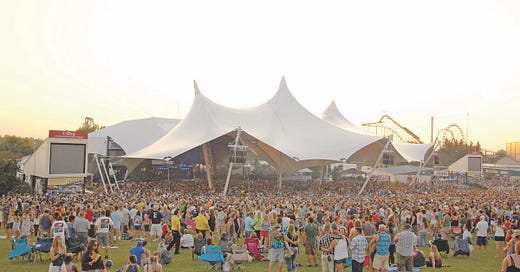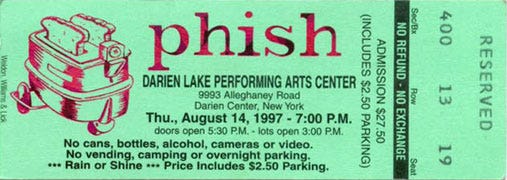SET 1: Ya Mar, Funky Bitch > Fluffhead, Limb By Limb, Free, Cars Trucks Buses, Tela > Train Song > Billy Breathes, Run Like an Antelope
SET 2: Chalk Dust Torture, Love Me, Sparkle > Harry Hood -> Jam > Colonel Forbin's Ascent -> Merry Pranksters Jam -> Camel Walk, Taste
ENCORE: Bouncing Around the Room, Rocky Top
[Sorry for the late post today, I’m at Alpine.]
Even two years after Jerry Garcia’s death, Phish can’t seem to shake the shadow of the Dead. In 1996, they struggled with the burden of being America’s #1 Jamband, but by 1997, it seemed they were finally at peace with assimilating that responsibility into their own path. Trey made a nice little nod and speech at Shoreline for Jerry’s birthday, promising that they would keep “his spirit alive through music,” but refusing to make the overt nod of a Dead cover (that would have to wait one more year). Meanwhile, the directions that Phish are actively pushing towards – funk, indie rock songwriting, and shoegaze walls of noise – have only the thinnest connections back to the idealized 60s the Dead came to represent in the 90s.
But in the final show before Phish gets to the festival finish line, the summer tour intersects with classic psychedelic history in the form of Ken Kesey and the Merry Pranksters, who borrowed the Furthur bus back from the Rock & Roll Hall of Fame for an outing to western New York. Three-quarters into a show that was on the disconnected and sloppy side – the off-key Love Me in the second set might be the worst Phish has sounded all year, the post-Hood jam is interesting, but goes nowhere – Trey queues up the first narration song of the year, fifty shows into the calendar. And after a few introductory comments, he yields the storytelling floor to legendary author Ken Kesey who…doesn’t give it back easily.
The Wizard of Oz-themed narrative is based off material in Kesey’s multimedia play Twister: A Ritual Reality in Three Quarters Plus Overtime if Necessary. Kesey sets up the conflict as a search for the Bozos, who have been missing for two years (hmm, what happened two years ago?). He brings out a sequence of poorly-amplified guests, including the Scarecrow, the Tin Man, and…Frankenstein. Each tells a brief story, accompanied by Phish on live score, playing Somewhere Over The Rainbow, If I Only Had a Brain, and…Frankenstein, where appropriate.
It builds into chaos that’s only partially captured by the tape; according to the eyewitness accounts on phish.net, there were additional costumed performers roaming the stage and the audience, an early rough draft of many Phish New Year’s gags to come. By the end, Kesey and his compatriots are almost rapping about their Bozos as Phish slides into yet another 1997 funk jam. Kesey tries to help Phish close out the segment by shifting the topic to mockingbirds, but Trey says no, announcing that “the funk is too deep” and pivoting to Camel Walk as the Pranksters depart.
Okay, that all sounds pretty fun written down, and it’s worth hearing once. But it doesn’t really work. Even Trey seems to sense it in the moment, joking (lovingly, I think) “See what happens when you take too much acid, 30 years later?” as he retakes the wheel. Despite Phish’s obvious respect for their psychedelic ancestors, there’s a generation gap that the appearance can’t quite cross.
Phish were never natural at being a 60s hippie throwback, much more comfortable in the late 70s influence waters of prog and AOR and early alternative/college-rock. While they’re more than happy to credit the Dead for inspiring their operations, it’s usually more structural than musical: two-set shows, revolving setlists, and the like. In choosing that format, it caused the same kind of traveling party scene to grow up around them, almost unintentionally – people don’t typically follow bands who play the same setlist every night, and it’s the traveling fans that transform your typical concert tailgate into a Lot Scene. But the lot was never the point of Phish; it wasn’t really the point of the Dead either, but it was closer to the center of their cultural mission.

It’s a diminution, but the Pranksters were the forefathers of the Dead lot scene, where people born too young to experience the 60s strived to recreate the legend of the Acid Tests in carparks and venue grounds across the country. The Pranksters famously traveled by parking a big psychedelic bus outside a concert, and fans visiting Furthur as a museum piece in the hours before the show was a more natural intersection of these worlds than the in-show appearance.
Onstage, on Phish’s turf, it feels uncomfortable, like the Pranksters are trying to insert themselves into a story where they may be welcome but they’re not required. A Kesey line like “How can we keep the rock and roll going without the Bozos?” leave a bad taste in my mouth; it feels like the previous generation refusing to let a scene evolve without them at the center. Subsequently, breaking their own tradition and going into Camel Walk instead of Fly Famous Mockingbird feels like Phish reclaiming their agency.
1997 very well could have been a further development in Phish becoming “The New Dead;” part of its triumph is that they distanced themselves from that obligation. Phish didn’t try to sound more like the Dead as they absorbed their scene, they pushed in the opposite direction and fought to define their own space. The Pranksters’ appearance is also awkwardly timed to be immediately overshadowed in the wake of The Great Went, a space where Phish would continue to craft their own identity, taking what they wanted from the Dead and the Pranksters, but also finding inspiration in David Lynch, European raves, and Burning Man. So the Pranksters appearance is a bit like a well-meaning but misguided present from your grandparents; Phish accepts it, smiles politely, and puts it on a closet shelf to collect dust.





I was third row at this show and it was quite an odd thing to witness. I can say I will never forget this show. The camel walk was fun I remember after that cluster-f*ck ;) !
Incredibly incisive observations about the who, what, why and how Phish was able to escape the monumental post-95 shadow of the Grateful Dead. In the end, Phish has simply done what the Grateful Dead did: do their own thing to great effect, appreciation and growth through the decades. It's all good.